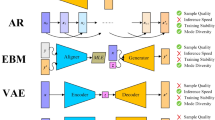Abstract
In this paper, we propose a method for automatically controlling the learning rate of Generative Adversarial Networks (GANs) so as to stabilize the training of GANs. In recent years, GAN has been successful in various types of image generation tasks. Since GAN trains Generators and Discriminators adversarially, it is very important to keep the balance of their learning progress. However, it is known that the adjustment of learning rate of GAN is extremely difficult compared to conventional networks. Thus, we in this paper propose a method for predicting the future training progress of GANs from the current state of Generators and Discriminators, and for automatically controlling the learning rate of GANs appropriately. The proposed method has been tested using several different GANs, and the results show the proposed method can control the learning rate of GANs appropriately for a variety of tasks.
Access this chapter
Tax calculation will be finalised at checkout
Purchases are for personal use only
Similar content being viewed by others
References
Abadi, M., et al.: Large-scale machine learning on heterogeneous systems (2015). https://www.tensorflow.org/
Bergstra, J., Yamins, D., Cox, D.D.: Making a science of model search: hyperparameter optimization in hundreds of dimensions for vision architectures. In:Proceedings of the 30th International Conference on Machine Learning (ICML 2013), pp. I-115–I-123 (2013)
Fukushima, K., Miyake, S.: Neocognitron: a new algorithm for pattern recognition tolerant of deformations and shifts in position. Pattern Recogn. 15(6), 455–469 (1982)
Goodfellow, I., et al.: Generative adversarial nets. In: Advances in Neural Information Processing Systems, pp. 2672–2680 (2014)
Hansen, N., Ostermeier, A.: Adapting arbitrary normal mutation distributions in evolution strategies: the covariance matrix adaptation. In: Proceedings of IEEE International Conference on Evolutionary Computation, pp. 312–317 (1996)
Heusel, M., Ramsauer, H., Unterthiner, T., Nessler, B., Hochreiter, S.: GANs trained by a two time-scale update rule converge to a local Nash equilibrium. In: Conference on Neural Information Processing Systems (NIPS) (2017)
Isola, P., Zhu, J.Y., Zhou, T., Efros, A.A.: Image-to-image translation with conditional adversarial networks. In: IEEE Conference on Computer Vision and Pattern Recognition (CVPR), pp. 1125–1134 (2017)
LeCun, Y., Cortes, C., Burges, C.J.: MNIST handwritten digit database, yann lecun, corinna cortes and chris burges. http://yann.lecun.com/exdb/mnist/
Mirza, M., Osindero, S.: Conditional generative adversarial nets. arXiv preprint arXiv:1411.1784, pp. 1–7 (2014)
Nelder, J.A., Mead, R.: A simplex method for function minimization. Comput. J. 7, 308–313 (1965)
Preferred Networks, I.: Automatic hyperparameter optimization framework for machine learning. https://www.preferred.jp/en/projects/optuna/
Salimans, T., Goodfellow, I., Zaremba, W., Cheung, V., Radford, A., Chen, X.: Improved techniques for training GANs. In: NIPS 2016 (2016)
Snoek, J., Larochelle, H., Adams, R.P.: Practical Bayesian optimization of machine learning algorithms. In: NIPS 2012: Proceedings of the 25th International Conference on Neural Information Processing Systems, vol. 2, pp. 2951–2959 (2012)
Szegedy, C., et al.: Going deeper with convolutions. In: IEEE Conference on Computer Vision and Pattern Recognition (CVPR) (2015)
Xiao, H., Rasul, K., Vollgraf, R.: Fashion-MNIST: a novel image dataset for benchmarking machine learning algorithms (2017)
Zhu, J., Park, T., Isola, P., Efros, A.: Unpaired image-to-image translation using cycle-consistent adversarial networks. In: Proceedings of the International Conference on Computer Vision, pp. 2223–2232 (2017)
Author information
Authors and Affiliations
Corresponding author
Editor information
Editors and Affiliations
Rights and permissions
Copyright information
© 2022 The Author(s), under exclusive license to Springer Nature Switzerland AG
About this paper
Cite this paper
Kamiya, T., Sakaue, F., Sato, J. (2022). Deep Automatic Control of Learning Rates for GANs. In: Sumi, K., Na, I.S., Kaneko, N. (eds) Frontiers of Computer Vision. IW-FCV 2022. Communications in Computer and Information Science, vol 1578. Springer, Cham. https://doi.org/10.1007/978-3-031-06381-7_8
Download citation
DOI: https://doi.org/10.1007/978-3-031-06381-7_8
Published:
Publisher Name: Springer, Cham
Print ISBN: 978-3-031-06380-0
Online ISBN: 978-3-031-06381-7
eBook Packages: Computer ScienceComputer Science (R0)




